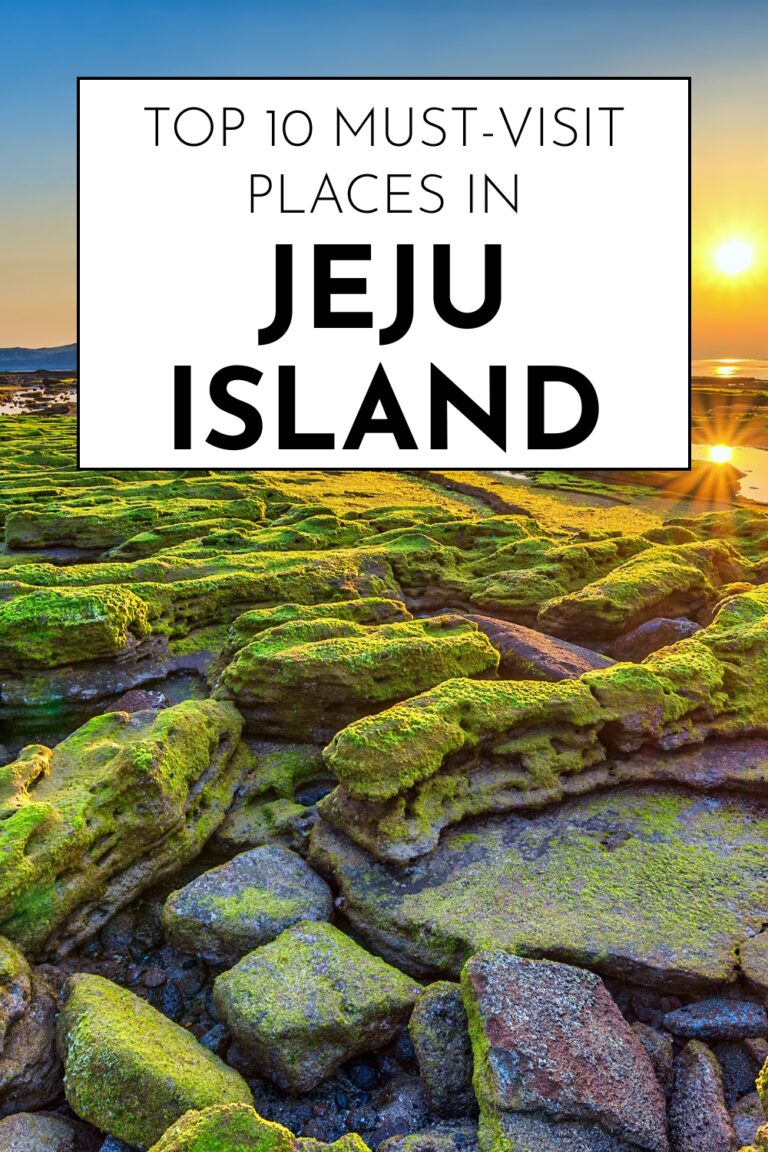South Korea’s largest island, Jeju, sits like a jewel in the Korea Strait, offering visitors an extraordinary blend of natural wonders, cultural heritage, and modern attractions. Located about 85 kilometers south of the Korean Peninsula, this volcanic island has earned recognition as both a UNESCO World Heritage Site and one of the New Seven Wonders of Nature.
Jeju Island’s appeal lies in its incredible diversity packed into a relatively small area. Ancient volcanic landscapes create dramatic coastlines and mysterious lava tube caves, while pristine beaches and crystal-clear waters rival any tropical destination. The island’s unique culture, shaped by centuries of isolation and influenced by strong-willed women divers called “haenyeo,” adds depth to its natural beauty.
What makes Jeju truly special is how it seamlessly blends traditional Korean culture with stunning natural phenomena. From towering Hallasan Mountain at its center to the dramatic cliffs and waterfalls around its perimeter, every corner of the island offers something remarkable. The subtropical climate creates lush forests and allows for year-round outdoor activities, while the island’s famous tangerines and fresh seafood provide unforgettable culinary experiences.
Modern Jeju has embraced tourism while preserving its natural character. World-class resorts and attractions complement hiking trails and traditional villages, creating options for every type of traveler. Whether you’re seeking adventure, relaxation, cultural immersion, or family fun, Jeju delivers experiences that explain why it’s become one of Asia’s most popular destinations.
The island’s compact size makes it possible to explore multiple attractions in a single day, yet its depth rewards longer stays with hidden gems and seasonal changes that reveal new beauty throughout the year.
Let’s explore the ten most spectacular places that make Jeju Island an essential destination for anyone traveling to South Korea.
1. Hallasan National Park – Majestic Mountain Peak
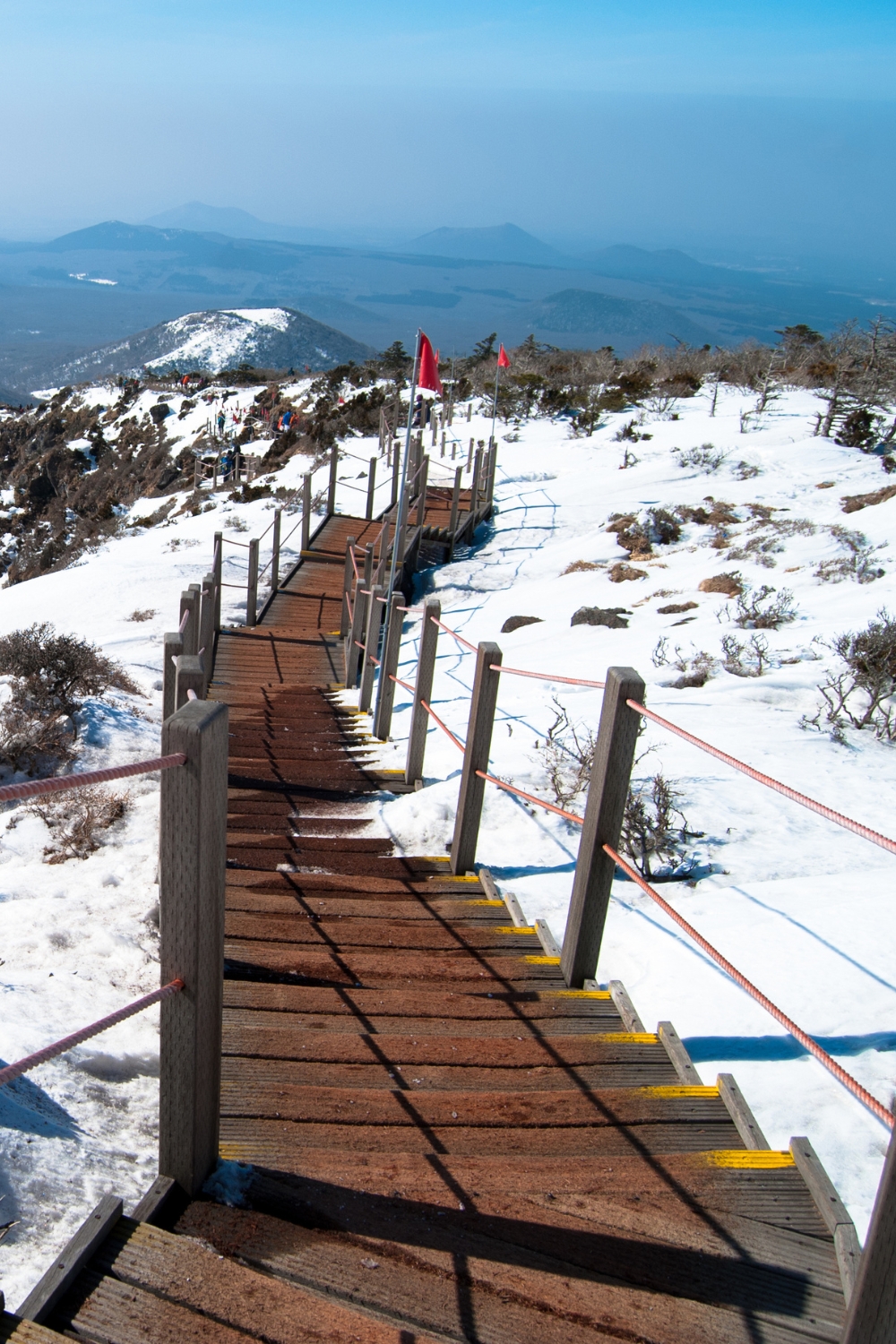
Hallasan, South Korea’s highest mountain at 1,947 meters, dominates Jeju Island’s landscape and serves as both its spiritual and geographical center. This dormant volcano, whose name means “mountain high enough to pull down the galaxy,” offers some of the most rewarding hiking experiences in East Asia.
Hiking Trails and Natural Beauty
The mountain features multiple hiking trails that cater to different skill levels and time commitments. The most popular routes include the Seongpanak Trail, which offers a gentler ascent through diverse forest ecosystems, and the Gwaneumsa Trail, which provides more challenging terrain but spectacular views.
Each trail reveals different aspects of Hallasan’s unique ecosystem. Hikers pass through temperate forests at lower elevations, cool-climate vegetation zones higher up, and finally reach alpine environments near the summit. The seasonal changes are particularly dramatic, with cherry blossoms in spring, lush greenery in summer, brilliant autumn colors, and snow-capped winter landscapes.
Summit Crater and Baengnokdam Lake
The summit crater, called Baengnokdam, contains a pristine lake that adds mystical beauty to the mountain’s peak. The crater lake, formed by volcanic activity thousands of years ago, reflects the sky and surrounding peaks, creating perfect photo opportunities for those who complete the challenging summit hike.
The area around the crater supports unique plant species that have adapted to the harsh mountain environment. The sense of achievement from reaching South Korea’s highest point, combined with the spectacular 360-degree views of Jeju Island and the surrounding ocean, makes this one of the most rewarding hiking experiences in the country.
Difficulty: Moderate to challenging
Summit hiking time: 8-10 hours round trip
Best seasons: Spring through fall
Entry fee: 1,000 KRW
2. Seongsan Ilchulbong (Sunrise Peak) – Volcanic Wonder
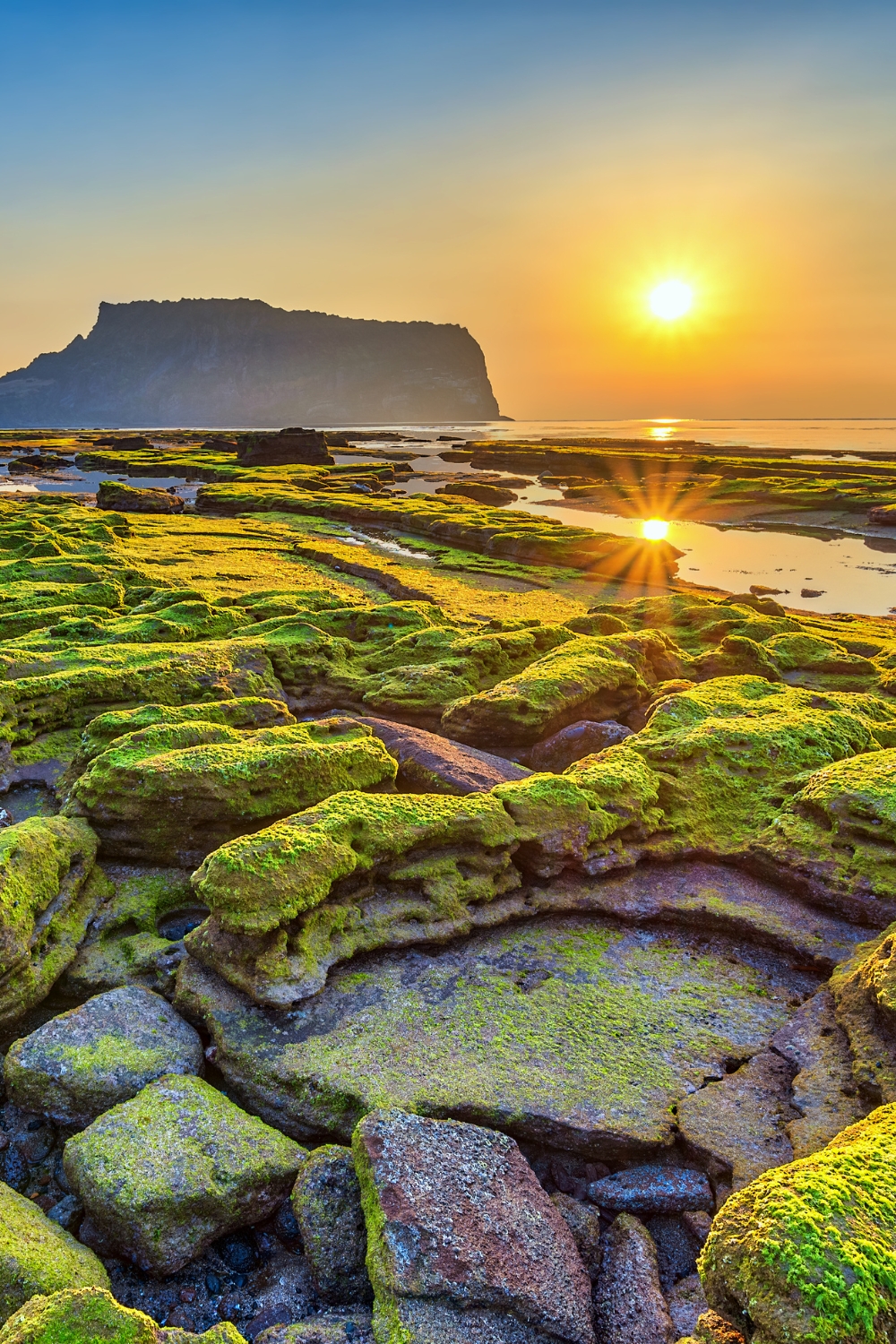
Seongsan Ilchulbong, also known as Sunrise Peak, stands as one of Jeju’s most iconic landmarks and a UNESCO World Heritage Site. This 180-meter volcanic cone, formed by underwater eruptions over 5,000 years ago, creates a dramatic silhouette against the ocean and offers unparalleled sunrise views.
Sunrise Spectacle and Photography
The peak earned its name from the breathtaking sunrise views that can be witnessed from its summit. Visitors who make the early morning climb are rewarded with the sun rising over the ocean, illuminating the volcanic crater and casting golden light across the surrounding landscape.
The hike to the summit takes about 30 minutes and involves well-maintained stairs and pathways. The trail offers multiple viewpoints for photography, and the summit provides 360-degree views of Jeju’s eastern coastline, rural landscapes, and neighboring islands.
Geological Significance and Crater Formation
The perfectly preserved volcanic crater at the summit showcases the dramatic geological forces that shaped Jeju Island. The crater’s bowl-like formation, surrounded by rocky peaks, creates a natural amphitheater that demonstrates the power of underwater volcanic activity.
Information boards around the site explain the volcanic formation process and the unique geological features that earned Seongsan Ilchulbong its UNESCO designation. The site serves as an excellent introduction to understanding Jeju’s volcanic origins and ongoing geological significance.
Climbing time: 30 minutes to summit
Best time: Early morning for sunrise
Entry fee: 5,000 KRW for adults
UNESCO status: World Heritage Site
3. Manjanggul Cave – Underground Marvel
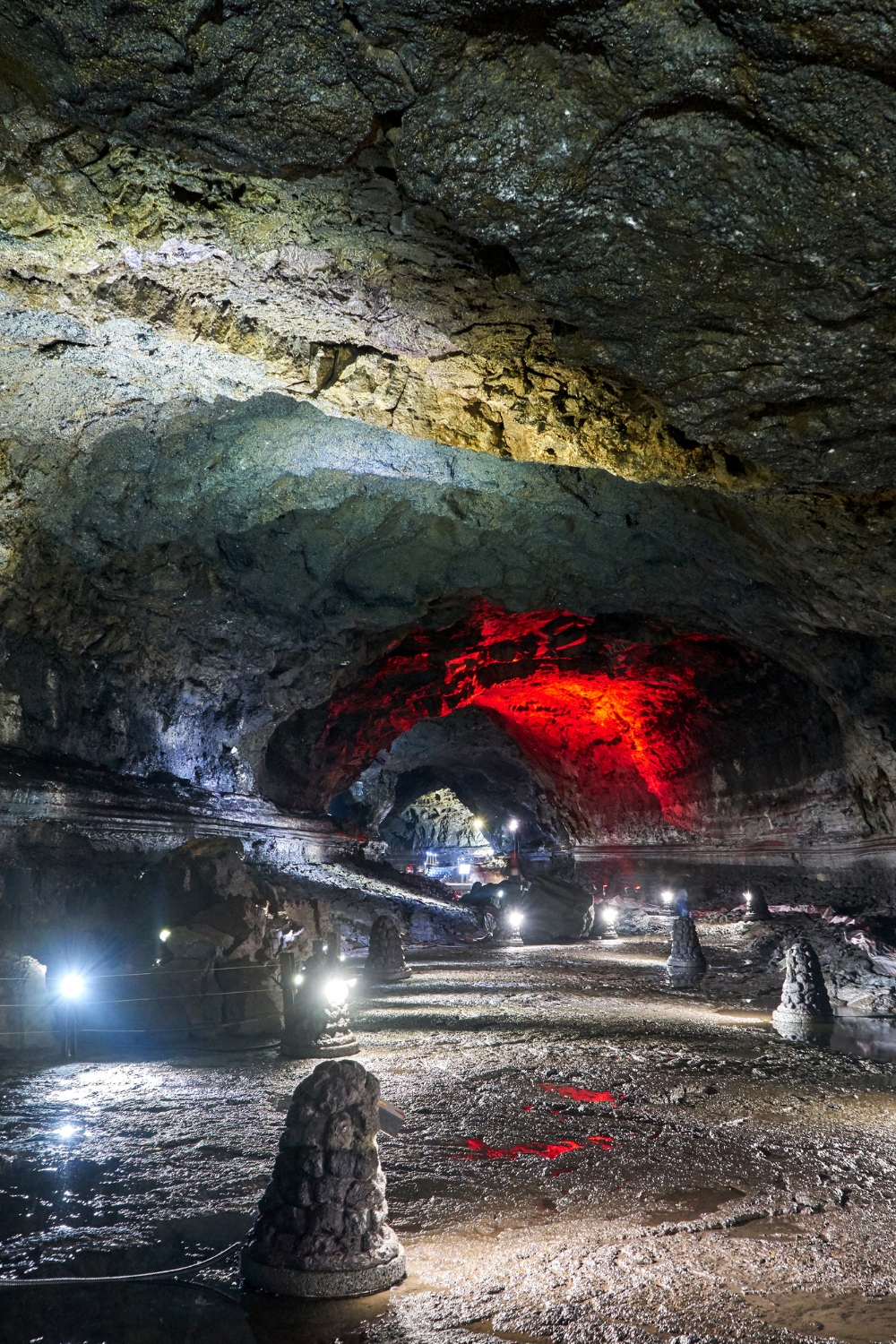
Manjanggul Cave represents one of the world’s longest lava tube systems and offers visitors a chance to explore Jeju’s underground volcanic landscape. This natural tunnel, formed by flowing lava over 200,000 years ago, stretches for over 8 kilometers, though only 1 kilometer is open to public exploration.
Lava Tube Formation and Geological Wonders
The cave system was created when the outer layer of a lava flow cooled and hardened while the inner molten lava continued flowing, eventually leaving behind these magnificent tubes. The result is a natural underground cathedral with impressive formations, including lava shelves, flowstone, and massive lava columns.
The cave maintains a constant temperature of 11-21°C year-round, making it a perfect refuge from Jeju’s hot summers or cold winters. The interior features dramatic lighting that highlights the cave’s natural formations and creates an otherworldly atmosphere.
Underground Exploration and Education
The accessible portion of the cave includes well-lit walkways and informational displays that explain the formation process and the cave’s ecological significance. The journey through the tube reveals different chambers and formations, culminating in a massive lava column that stands as one of the world’s largest.
The cave serves as home to various bat species and other cave-dwelling creatures, adding biological significance to its geological importance. Educational programs and guided tours provide deeper insights into the cave’s formation and its role in understanding volcanic activity.
Length open to public: 1 kilometer
Temperature: 11-21°C year-round
Walking time: 60-90 minutes
Entry fee: 4,000 KRW for adults
4. Cheonjiyeon Waterfall – Tropical Paradise
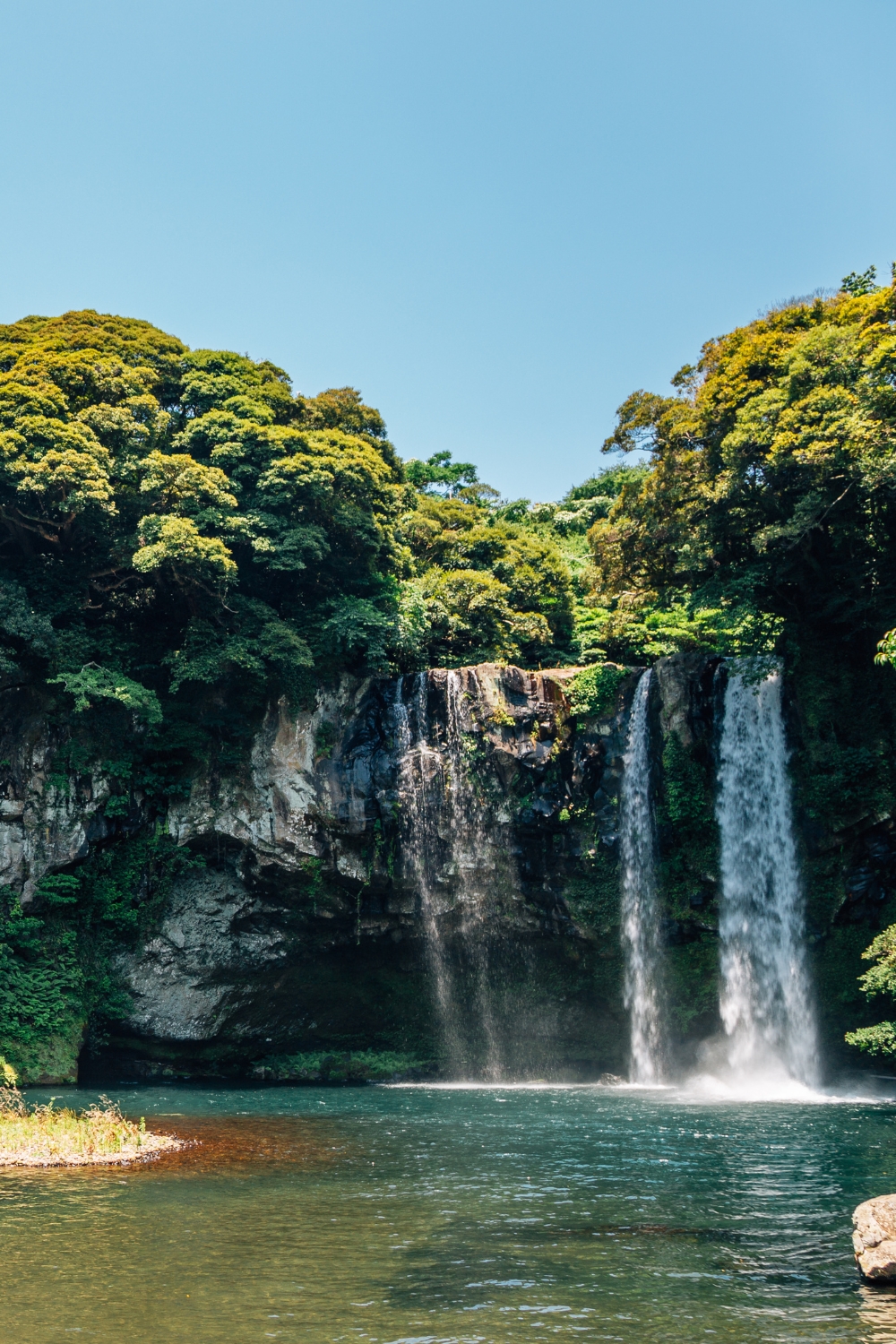
Cheonjiyeon Waterfall, whose name means “sky connected with land,” creates a tropical oasis in the heart of Jeju Island. This 22-meter waterfall cascades into a crystal-clear pool surrounded by lush subtropical vegetation, creating one of the island’s most photogenic and romantic locations.
Waterfall Beauty and Natural Setting
The waterfall drops dramatically over volcanic rock formations into a deep pool that reflects the surrounding cliffs and vegetation. The constant mist from the falling water creates a microclimate that supports unique plant species, including rare ferns and tropical flowers that add vibrant colors to the landscape.
Evening illumination transforms the waterfall into a magical spectacle, with colored lights highlighting the water’s movement and the surrounding rock formations. The combination of rushing water, lush vegetation, and dramatic lighting creates perfect conditions for photography and romantic moments.
Subtropical Flora and Wildlife
The area around Cheonjiyeon supports some of Jeju’s most diverse plant communities, including native species that thrive in the waterfall’s humid microclimate. The walking trail through the botanical area showcases various subtropical plants, many of which are found nowhere else in Korea.
The waterfall area serves as habitat for various bird species and other wildlife that depend on the water source and rich plant life. Night visits often reveal different wildlife activity, including nocturnal creatures that emerge after dark.
Height: 22 meters
Best photography: Evening with illumination
Walking trail: 30-minute loop
Entry fee: 2,500 KRW for adults
5. Hyeopjae Beach – Crystal Clear Waters
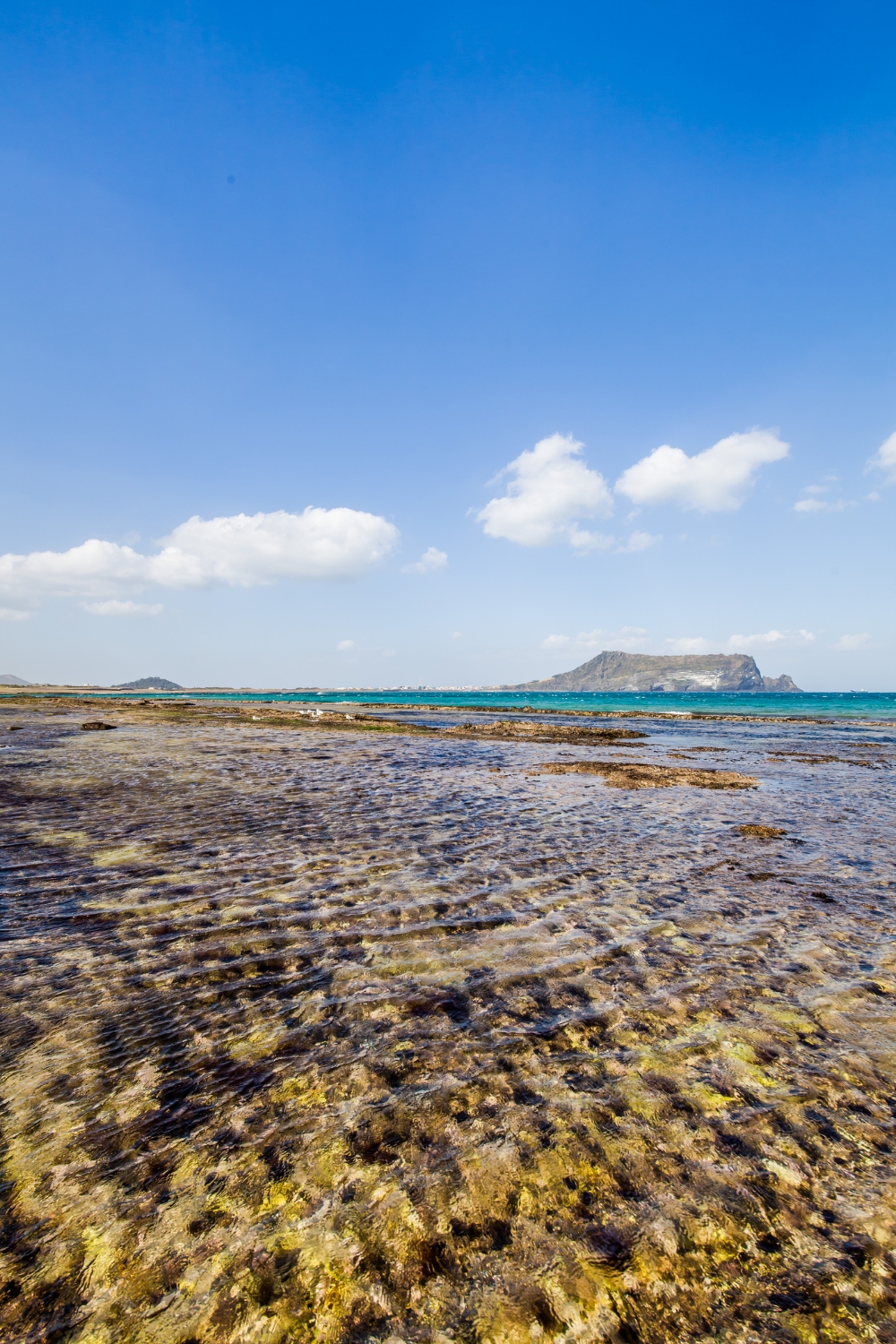
Hyeopjae Beach stands out as one of Jeju’s most beautiful beaches, featuring pristine white sand and crystal-clear emerald waters that rival any tropical destination. Located on the island’s western coast, this beach offers perfect swimming conditions and stunning sunset views.
Beach Activities and Water Sports
The beach’s shallow, clear waters make it ideal for swimming, snorkeling, and various water sports. The sandy bottom extends far from shore, creating safe swimming areas for families with children. The water clarity allows for excellent visibility, making it perfect for observing marine life and underwater photography.
Kayaking, windsurfing, and other water sports are popular activities, with rental equipment available from beachside vendors. The beach’s western orientation provides excellent sunset viewing opportunities, with the sun setting directly over the ocean horizon.
Coastal Scenery and Relaxation
The beach is backed by pine forests and offers excellent facilities including showers, changing rooms, and beachside cafes. The contrast between the white sand, emerald water, and green pine trees creates postcard-perfect scenery that attracts photographers and beach lovers alike.
The area around Hyeopjae Beach includes other attractions such as Hallim Park and nearby caves, making it possible to combine beach relaxation with sightseeing activities. The beach maintains a peaceful atmosphere even during busy seasons, with plenty of space for privacy and relaxation.
Beach type: White sand
Water clarity: Excellent
Best time: May through October
Facilities: Complete beach amenities
6. Jeju Folk Village – Cultural Heritage
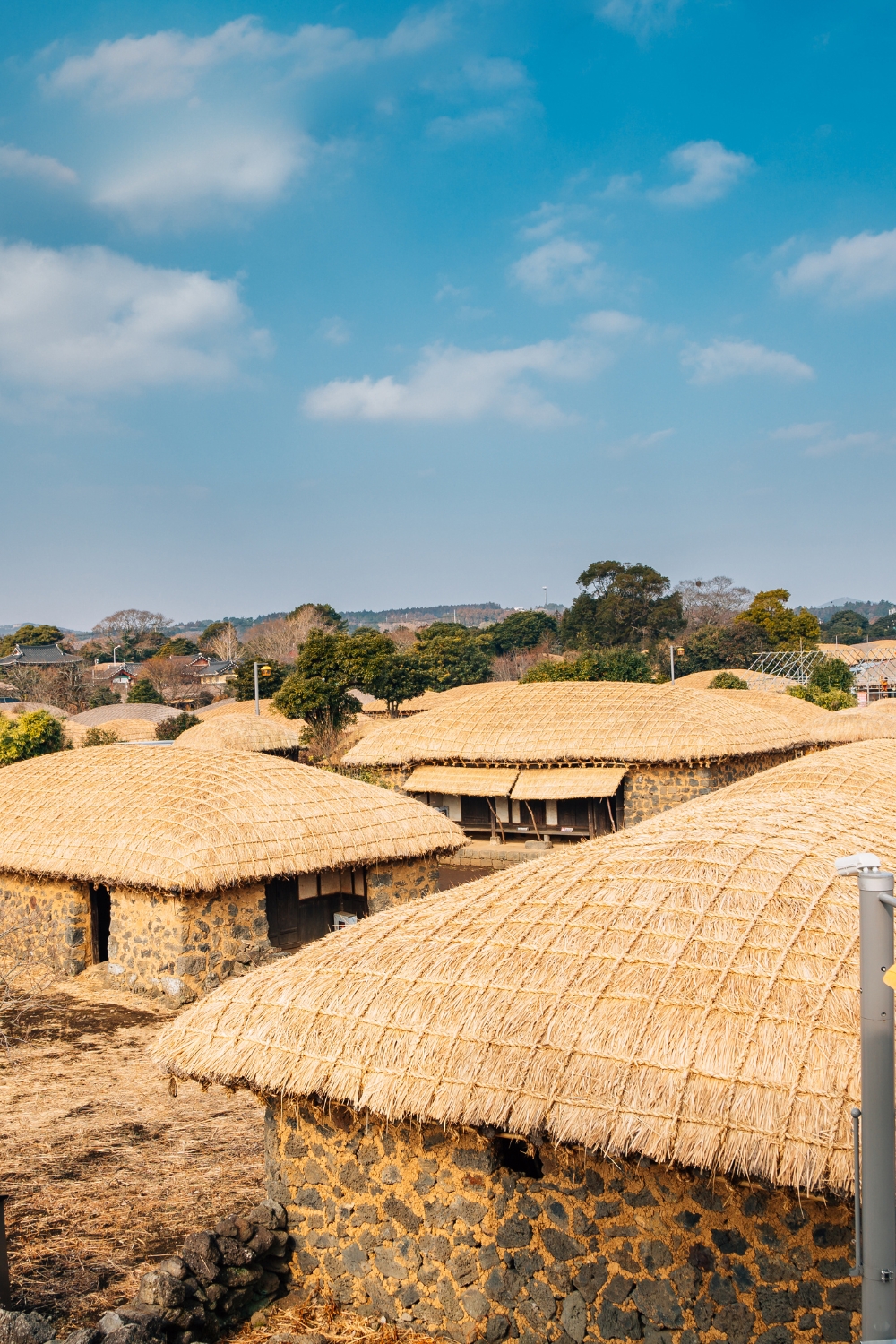
Jeju Folk Village preserves and showcases traditional Jeju culture through authentic buildings, demonstrations, and cultural experiences. This living museum recreates historical Jeju life and provides insight into the island’s unique cultural heritage that developed in isolation from mainland Korea.
Traditional Architecture and Lifestyle
The village features over 100 traditional buildings relocated from around the island, including thatched-roof houses, stone walls, and traditional work areas. Each building demonstrates different aspects of traditional Jeju life, from residential architecture to agricultural and fishing activities.
Costumed interpreters demonstrate traditional crafts, farming techniques, and daily life activities. Visitors can observe traditional weaving, pottery making, and other crafts that were essential to Jeju’s historical economy. The demonstrations provide hands-on learning opportunities and photo experiences.
Cultural Performances and Experiences
Regular cultural performances showcase traditional Jeju music, dance, and storytelling. The performances often feature the island’s unique shamanic traditions and folk tales that reflect Jeju’s distinct cultural identity.
Interactive experiences allow visitors to try traditional activities such as grinding grain, making traditional foods, or participating in folk games. These hands-on activities provide deeper cultural understanding and create memorable experiences for visitors of all ages.
Operating hours: 8:30 AM – 6:00 PM
Cultural performances: Multiple times daily
Entry fee: 15,000 KRW for adults
Best for: Cultural education, family activities
7. Udo Island – Pristine Island Escape
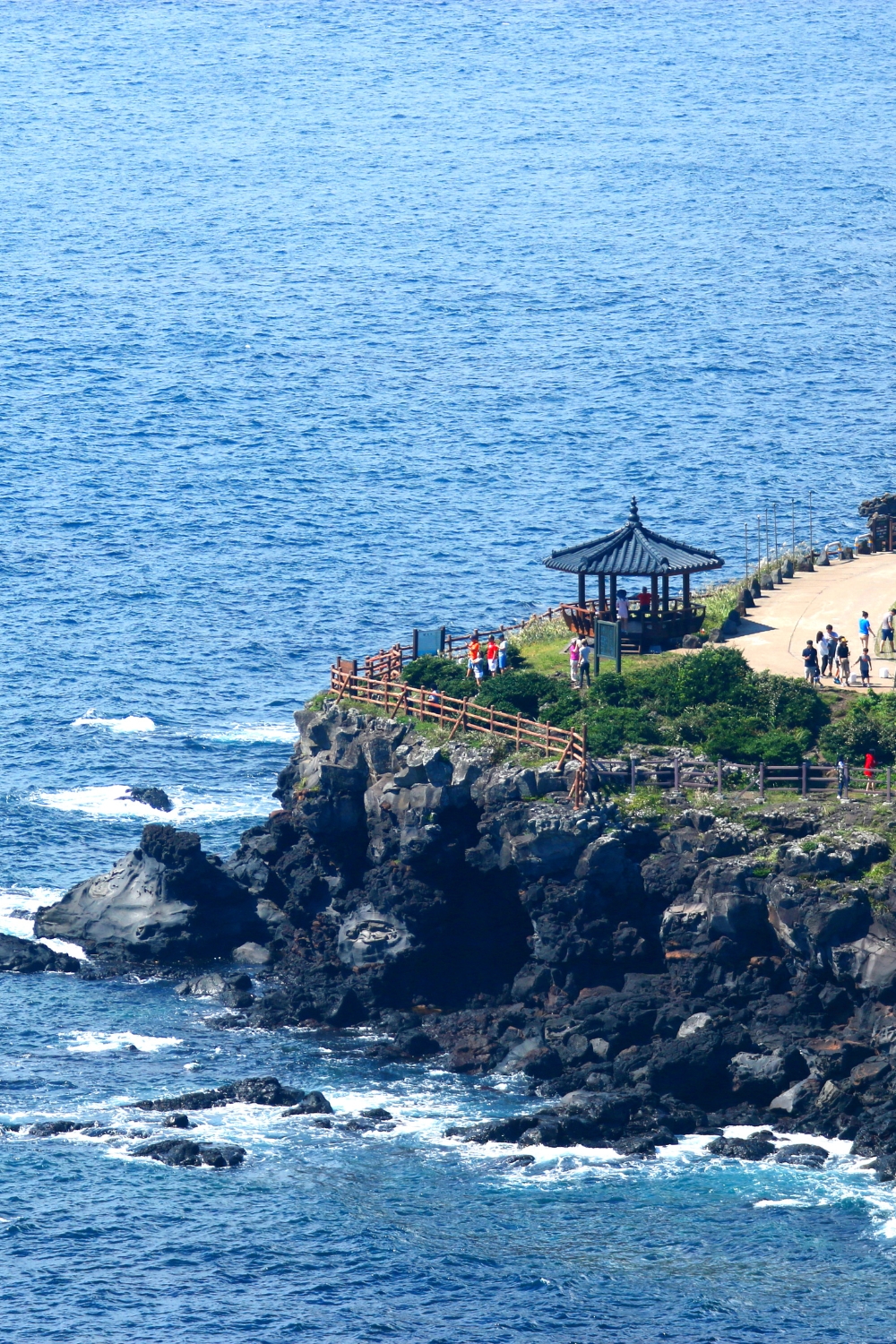
Udo Island, located just off Jeju’s eastern coast, offers a perfect day trip escape with pristine beaches, traditional rural landscapes, and a slower pace of life. This small island, accessible by a short ferry ride, provides a glimpse into traditional island life while offering some of Korea’s most beautiful coastal scenery.
Island Beaches and Coastal Beauty
Udo features several stunning beaches, including Hagosudong Beach with its unique black sand and Seobinbaeksa Beach with pristine white sand. Each beach offers different characteristics and activities, from swimming and sunbathing to beachcombing and photography.
The island’s coastline features dramatic cliffs, hidden coves, and crystal-clear waters that create perfect conditions for various water activities. The relatively undeveloped nature of the island means beaches remain uncrowded and pristine, offering a more authentic island experience.
Traditional Island Life and Local Culture
Udo maintains traditional fishing and farming communities that showcase authentic Korean island life. Visitors can observe traditional farming techniques, meet local fishermen, and experience the slower pace of island living that contrasts with mainland Korea’s rapid development.
The island is famous for its peanuts and peanut ice cream, which have become signature local products. Traditional restaurants serve fresh seafood and local specialties that reflect the island’s maritime culture and agricultural heritage.
Ferry ride: 15 minutes from Seongsan Port
Island size: 6 square kilometers
Best activities: Beach relaxation, cycling, cultural observation
Day trip duration: 4-6 hours
8. Teddy Bear Museum – Family Fun
The Teddy Bear Museum offers a whimsical break from Jeju’s natural attractions while providing entertainment for visitors of all ages. This unique museum showcases teddy bears from around the world and presents Korean history and culture through creative teddy bear displays.
Museum Exhibitions and Collections
The museum features extensive collections of teddy bears from different countries and time periods, including rare antique bears and contemporary artistic creations. The displays present Korean history, world history, and popular culture through elaborate teddy bear dioramas that combine education with entertainment.
Special exhibitions change regularly, featuring themes such as famous movies, historical events, or seasonal celebrations. The creative presentations make learning about history and culture engaging for children while providing nostalgic entertainment for adults.
Interactive Experiences and Shopping
The museum includes interactive areas where visitors can participate in teddy bear-related activities and photo opportunities. The extensive gift shop offers unique teddy bear souvenirs and Jeju-themed bears that make perfect gifts and travel mementos.
The museum’s location near other popular attractions makes it easy to combine with other activities. The air-conditioned environment provides comfortable indoor entertainment during hot weather or rainy days.
Operating hours: 9:00 AM – 7:00 PM
Entry fee: 11,000 KRW for adults
Best for: Families, rainy day activities
Gift shop: Extensive teddy bear collection
9. Jusangjeolli Cliff – Dramatic Coastline
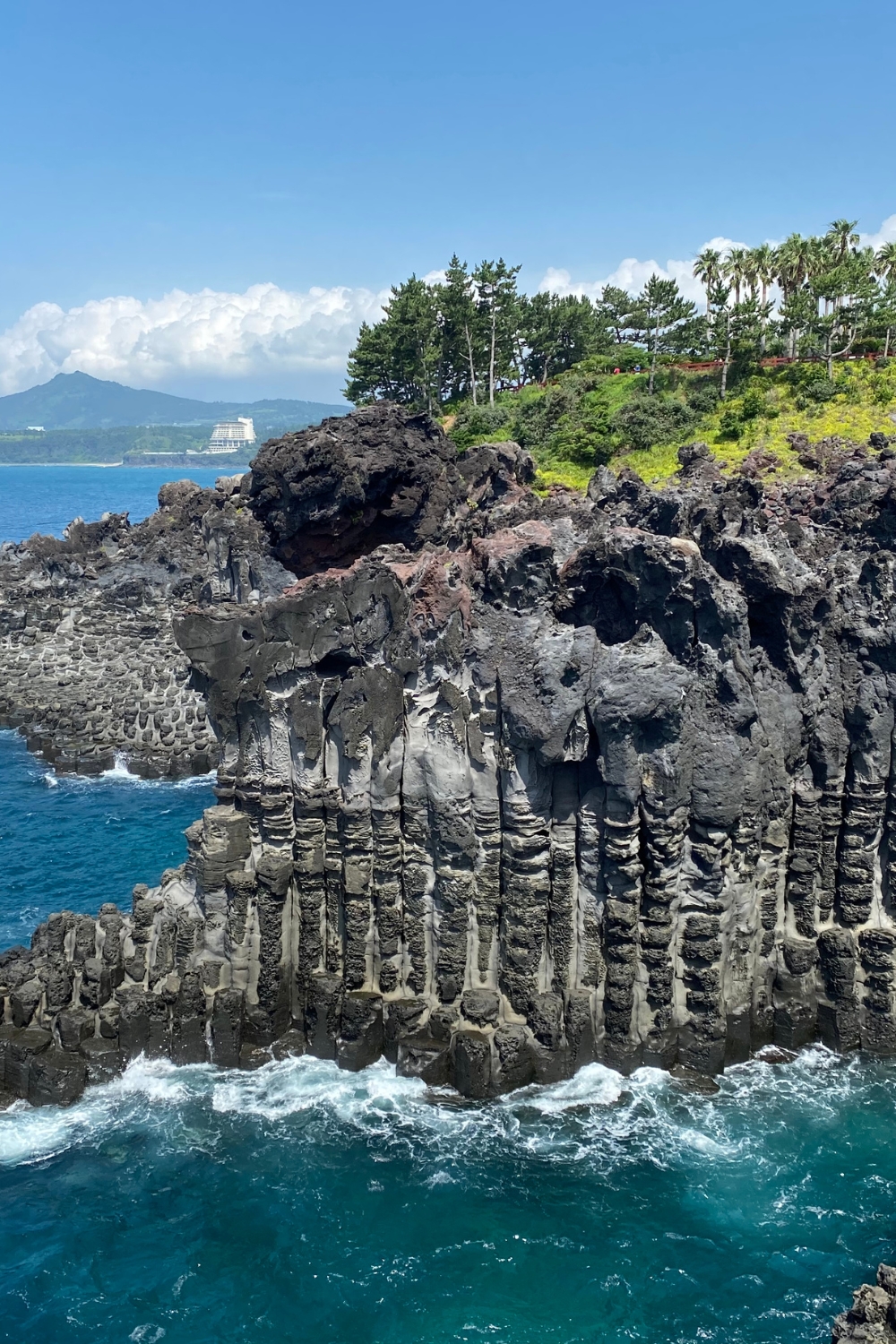
Jusangjeolli Cliff showcases one of Jeju’s most dramatic geological formations, featuring towering hexagonal basalt columns that rise directly from the ocean. These natural stone pillars, formed by volcanic activity, create a stunning coastline that demonstrates the island’s volcanic origins.
Geological Formation and Natural Beauty
The cliff was formed when lava from Hallasan Mountain flowed into the ocean and cooled rapidly, creating the distinctive hexagonal columns through a process called columnar jointing. The result is a natural wall of geometric stone formations that rise up to 20 meters above the crashing waves.
The contrast between the dark volcanic rock and the blue ocean creates dramatic visual compositions, especially during stormy weather when large waves crash against the cliff face. The geometric perfection of the natural columns challenges visitors’ perceptions of what nature can create.
Coastal Views and Photography
The cliff offers excellent viewing platforms and walking paths that provide different perspectives on the formations. The site is particularly spectacular during rough weather when powerful waves create dramatic spray and sound effects against the rock face.
Photography opportunities abound, with the geometric rock formations providing unique foreground elements for ocean and sky compositions. The site’s dramatic nature makes it popular for both professional photographers and casual visitors seeking impressive photos.
Rock formation: Hexagonal basalt columns
Height: Up to 20 meters
Best weather: Stormy conditions for dramatic waves
Photography: Excellent geometric compositions
10. Spirited Garden – Botanical Paradise
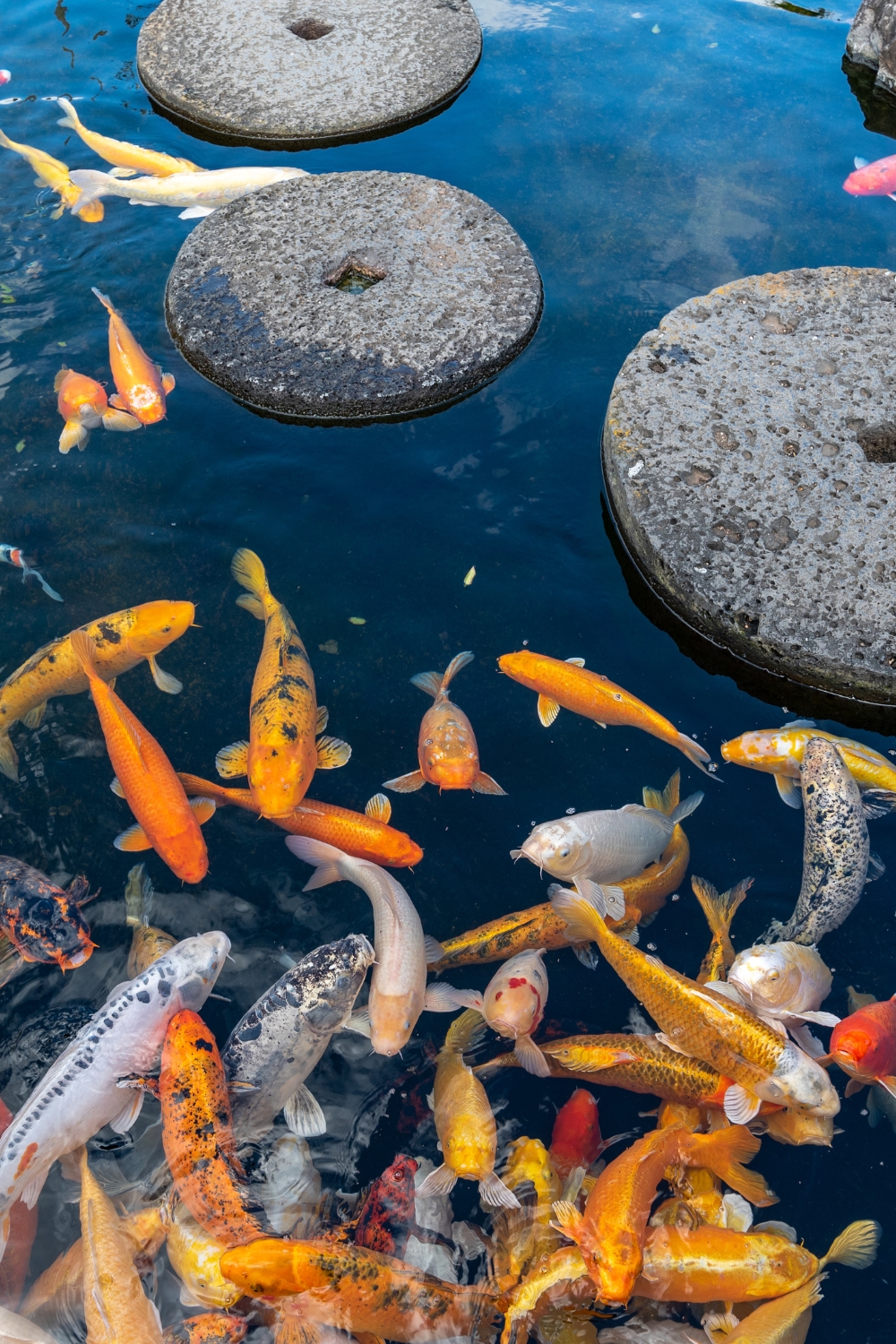
Spirited Garden represents the pinnacle of Korean bonsai art and garden design, featuring over 2,000 bonsai trees in a beautifully landscaped setting. This private garden showcases the artistic potential of miniature tree cultivation while providing a peaceful retreat surrounded by natural beauty.
Bonsai Art and Horticultural Excellence
The garden features an extensive collection of bonsai trees, some over 200 years old, arranged in artistic displays that demonstrate the highest levels of horticultural skill. The collection includes both traditional Korean species and international varieties, each carefully maintained and presented.
The bonsai displays change with the seasons, offering different experiences throughout the year. Spring brings delicate blossoms, summer provides lush green foliage, autumn showcases brilliant color changes, and winter reveals the artistic structure of bare branches.
Garden Design and Peaceful Atmosphere
The garden’s layout incorporates traditional Korean garden design principles with modern landscaping techniques. Stone pathways wind through carefully arranged displays, creating a meditative walking experience that encourages slow observation and appreciation.
The peaceful atmosphere makes the garden an ideal place for relaxation and contemplation. The combination of artistic achievement, natural beauty, and tranquil setting creates a unique experience that differs from Jeju’s more dramatic natural attractions.
Bonsai collection: Over 2,000 trees
Operating hours: 9:00 AM – 6:00 PM
Entry fee: 12,000 KRW for adults
Best for: Garden enthusiasts, peaceful relaxation
Planning Your Jeju Adventure
Getting to and Around Jeju
Jeju International Airport serves as the main gateway to the island, with frequent flights from Seoul, Busan, and other major Korean cities. International flights connect Jeju directly with major cities throughout Asia, making it easily accessible for international visitors.
Car rental is the most popular way to explore Jeju, offering maximum flexibility to visit attractions at your own pace. The island’s well-maintained roads and clear signage make driving relatively easy, though international visitors need proper documentation. Public buses connect major attractions, while taxi services are readily available for shorter trips.
Best Time to Visit
Spring (March-May): Perfect weather with mild temperatures and blooming flowers. Cherry blossoms and other spring flowers create beautiful landscapes. This is considered one of the best times to visit.
Summer (June-August): Warm weather ideal for beaches and water activities. This is peak season with higher prices and larger crowds, but perfect for beach lovers and water sports enthusiasts.
Fall (September-November): Excellent weather with comfortable temperatures and stunning autumn colors. This is another peak season that offers ideal conditions for hiking and outdoor activities.
Winter (December-February): Milder than mainland Korea with occasional snow on Hallasan. Lower prices and fewer crowds, though some outdoor activities may be limited.
Cultural Considerations and Local Etiquette
Jeju’s culture reflects both traditional Korean values and unique island characteristics. When visiting religious sites or traditional villages, dress modestly and show respect for local customs. Photography restrictions may apply at certain cultural sites.
The island’s famous “haenyeo” (female divers) represent an important cultural tradition that has been recognized by UNESCO. If you encounter these remarkable women, observe respectfully and ask permission before photographing.
Conclusion
Jeju Island offers an extraordinary combination of natural wonders, cultural heritage, and modern attractions that create unforgettable travel experiences. From the majestic heights of Hallasan Mountain to the crystal-clear waters of Hyeopjae Beach, from ancient lava tubes to pristine island escapes, each destination reveals different facets of this remarkable island paradise.
What makes Jeju truly special is its ability to surprise visitors with its diversity and beauty. The island’s volcanic origins have created landscapes that seem almost otherworldly, while its unique culture provides insights into traditional Korean life. Modern attractions complement natural wonders, ensuring something for every type of traveler.
These ten must-visit places represent the highlights of what Jeju has to offer, but they’re just the beginning of the island’s attractions. The island’s compact size makes it possible to experience multiple destinations in a single trip, while its depth rewards return visits with new discoveries and seasonal changes.
Whether you’re seeking adventure on volcanic peaks, relaxation on pristine beaches, cultural education in traditional villages, or family fun at unique attractions, Jeju Island delivers experiences that will exceed your expectations. The combination of natural beauty, cultural authenticity, and modern convenience makes Jeju an ideal destination for both first-time visitors to Korea and experienced travelers seeking something extraordinary.
Start planning your Jeju adventure today, and prepare to discover why this volcanic island has become one of Asia’s most beloved destinations. The ferry ride or flight to Jeju leads to experiences and memories that will last a lifetime, in a place where ancient volcanic forces have created a modern paradise.
